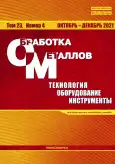Application of digital image processing technique in the microstructure analysisand the machinability investigation
- Authors: Sheladiya M.1, Acharya S.1, Kothari A.1, Acharya G.1
-
Affiliations:
- Issue: Vol 23, No 4 (2021)
- Pages: 21-32
- Section: TECHNOLOGY
- URL: https://bakhtiniada.ru/1994-6309/article/view/301958
- DOI: https://doi.org/10.17212/1994-6309-2021-23.4-21-32
- ID: 301958
Cite item
Abstract
About the authors
M. Sheladiya
Email: mvsheladiya@gmail.com
M.Tech.(Engineering), Assistant Professor, 1. Gujarat Technological University, Ahmedabad, 382424, India; 2. Atmiya University, Faculty of Engineering & Technology, Yogidham Gurukul, Kalawad Road, Rajkot, 360005, India; mvsheladiya@gmail.com
S. Acharya
Email: shailee.acharya@gmail.com
D.Sc. (Engineering), Sardar Vallabhbhai Patel Institute of Technology, Affiliated to GTU, Vasad, 388306, India, shailee.acharya@gmail.com
A. Kothari
Email: amkothari.ec@gmail.com
Doctor of Philosophy, Associate Professor, Atmiya University, Faculty of Engineering & Technology, Yogidham Gurukul, Kalawad Road, Rajkot, 360005, India, amkothari.ec@gmail.com
G. Acharya
Email: gdacharya@rediffmail.com
D.Sc. (Engineering), Professor, Atmiya Institute of Technology and Science, Yogidham Gurukul, Kalawad Road, Rajkot, 360005, India, gdacharya@rediffmail.com
References
- Image based analysis of complex microstructures of engineering materials / T. Wejrzanowski, W. Spychalski, K. Rózniatowski, K. Kurzydlowski // International Journal of Applied Mathematics and Computer Science. – 2008. – Vol. 18 (1). – P. 33–39.
- Samuels L.E. Light microscopy of carbon steels. – Materials Park, Ohio: ASM International, 1999.
- Electron backscatter diffraction in materials science / A.J. Schwartz, M. Kumar, B.L. Adams, D.P. Field. – 2nd ed. – New York: Springer US Publ., 2009. – 403 p. – ISBN 978-0-387-88135-5. – doi: 10.1007/978-0-387-88136-2.
- Krauss G. Steels: processing, structure, and performance. – Materials Park, Ohio: ASM International, 2015.
- Understanding deep learning techniques for image segmentation / S. Ghosh, N. Das, I. Das, U. Maulik // ACM Computing Surveys (CSUR). – 2019. – Vol. 52 (4). – P. 1–35.
- Tu Z., Bai X. Auto-context and its application to high-level vision tasks and 3d brain image segmentation // IEEE Transactions on Pattern Analysis and Machine Intelligence. – 2009. – Vol. 32 (10). – P. 1744–1757.
- Kang B.-H. A review on image and video processing // International Journal of Multimedia and Ubiquitous Engineering. – 2007. – Vol. 2 (2). – P. 49–64.
- Collins T.J. Image for microscopy // Biotechniques. – 2007. – Vol. 43 (S1). – P. S25–S30.
- Kaur D., Kaur Y. Various image segmentation techniques: a review // International Journal of Computer Science and Mobile Computing. – 2014. – Vol. 3 (5). – P. 809–814.
- Dhanachandra N., Chanu Y.J. Image segmentation method using k-means clustering algorithm for color image // Advanced Research in Electrical and Electronic Engineering. – 2015. – Vol. 2 (11). – P. 68–72.
- Yedla M., Pathakota S.R., Srinivasa T.M. Enhancing K-means clustering algorithm with improved initial center // International Journal of Computer Science and Information Technologies. – 2010. – Vol. 1 (2). – P. 121–125.
- Dhanachandra N., Manglem K., Chanu Y.J. Image segmentation using K-means clustering algorithm and subtractive clustering algorithm // Procedia Computer Science. – 2015. – Vol. 54. – P. 764–771.
- Mode Inference using enhanced Segmentation and Pre-processing on raw Global Positioning System data / A. Nawaz, H. Zhiqiu, W. Senzhang, Y. Hussain, A. Naseer, M. Izhar, Z. Khan // Measurement and Control. – 2020. – Vol. 53 (7–8). – P. 1144–1158.
- Application of digital image processing for implementation of complex realistic particle shapes/morphologies in computer simulated heterogeneous microstructures / Singh H., Mao Y., A. Sreeranganathan, A.M. Gokhale // Modelling and Simulation in Materials Science and Engineering. – 2006. – Vol. 14 (3). – P. 351–363.
- Application of digital image processing for automatic detection and characterization of cracked constituent particles/inclusions in wrought aluminum alloys / S.G. Lee, Y. Mao, A.M. Gokhale, J. Harris, M.F. Horstemeyer // Materials Characterization. – 2009. – Vol. 60 (9). – P. 964–970.
- Kakani S.L. Material science. – New Delhi: New Age International, 2006. – 656 p.
- Narkhede H.P. Review of image segmentation techniques // International Journal of Science and Modern Engineering. – 2013. – Vol. 1 (8). – P. 54–61.
- Celebi M.E., Kingravi H.A., Vela P.A. A comparative study of efficient initialization methods for the k-means clustering algorithm // Expert Systems with Applications. – 2013. – Vol. 40 (1). – P. 200–210.
- Kodinariya T.M., Makwana P.R. Review on determining number of Cluster in K-Means Clustering // International Journal of Advance Research in Computer Science and Management Studies. – 2013. – Vol. 1 (6). – P. 90–95.
- Likas A., Vlassis N., Verbeek J.J. The global k-means clustering algorithm // Pattern Recognition. – 2003. – Vol. 36 (2). – P. 451–461.
- Vermunt J.K. K-means may perform as well as mixture model clustering but may also be much worse: Comment on Steinley and Brusco // Psychological Methods. – 2011. – Vol. 16, no. 1. – P. 82–88.
- Шеладия М.В., Ачарья Ш.Г., Ачарья Г.Д. Технологическое исследование влияния параметров механической обработки на срок службы инструмента // Обработка металлов (технология, оборудование, инструменты). – 2020. – Т. 22, № 4. – С. 41–53. – doi: 10.17212/1994-6309-2020-22.4-41-53.
- Moore W., Lord J.O. Gray cast iron machinability: quantitative measurements of graphite and pearlite effects // Modern Castings. – 1959. – Vol. 35 (4). – P. 55–60.
Supplementary files






